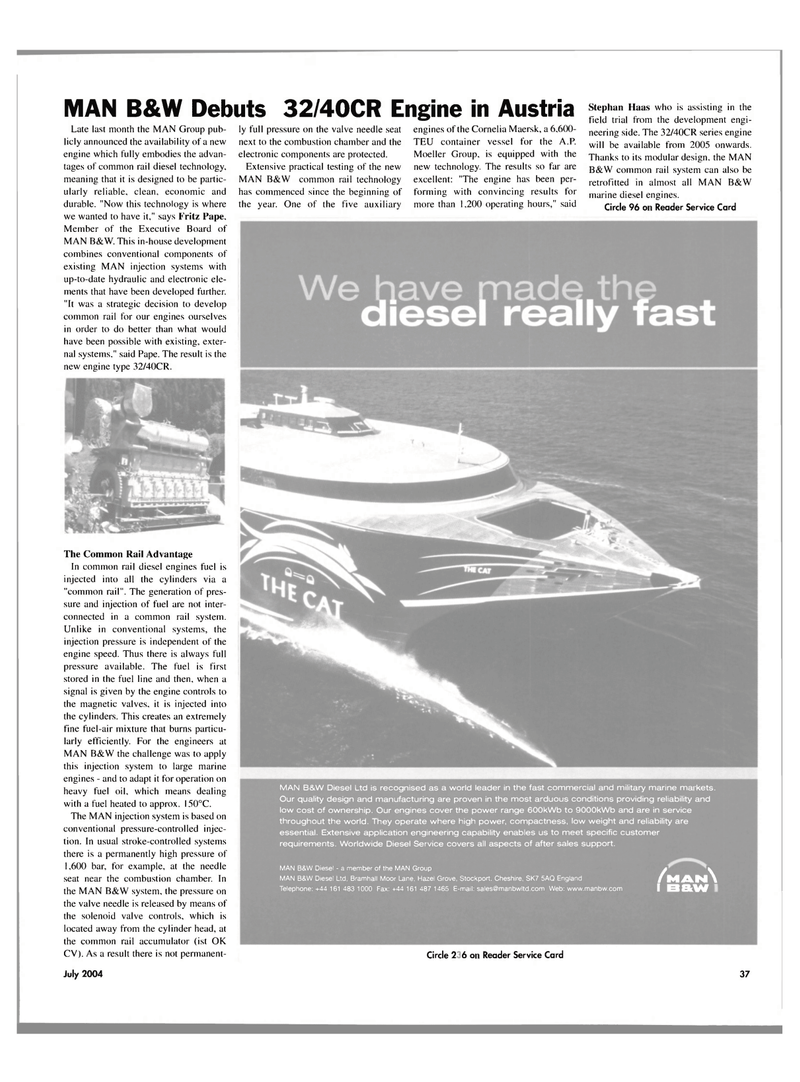
Page 37: of Maritime Reporter Magazine (July 2004)
Gulf of Mexico: Floating Production Systems & Support Vessels
Read this page in Pdf, Flash or Html5 edition of July 2004 Maritime Reporter Magazine
MAN B&W Debuts 32/40CR Engine in Austria
Late last month the MAN Group pub- licly announced the availability of a new engine which fully embodies the advan- tages of common rail diesel technology, meaning that it is designed to be partic- ularly reliable, clean, economic and durable. "Now this technology is where we wanted to have it," says Fritz Pape,
Member of the Executive Board of
MAN B&W. This in-house development combines conventional components of existing MAN injection systems with up-to-date hydraulic and electronic ele- ments that have been developed further. "It was a strategic decision to develop common rail for our engines ourselves in order to do better than what would have been possible with existing, exter- nal systems." said Pape. The result is the new engine type 32/40CR. ly full pressure on the valve needle seat next to the combustion chamber and the electronic components are protected.
Extensive practical testing of the new
MAN B&W common rail technology has commenced since the beginning of the year. One of the five auxiliary engines of the Cornelia Maersk, a 6,600-
TEU container vessel for the A.P.
Moeller Group, is equipped with the new technology. The results so far are excellent: "The engine has been per- forming with convincing results for more than 1,200 operating hours," said
Stephan Haas who is assisting in the field trial from the development engi- neering side. The 32/40CR series engine will be available from 2005 onwards.
Thanks to its modular design, the MAN
B&W common rail system can also be retrofitted in almost all MAN B&W marine diesel engines.
Circle 96 on Reader Service Card
The Common Rail Advantage
In common rail diesel engines fuel is injected into all the cylinders via a "common rail". The generation of pres- sure and injection of fuel are not inter- connected in a common rail system.
Unlike in conventional systems, the injection pressure is independent of the engine speed. Thus there is always full pressure available. The fuel is first stored in the fuel line and then, when a signal is given by the engine controls to the magnetic valves, it is injected into the cylinders. This creates an extremely fine fuel-air mixture that burns particu- larly efficiently. For the engineers at
MAN B&W the challenge was to apply this injection system to large marine engines - and to adapt it for operation on heavy fuel oil, which means dealing with a fuel heated to approx. 150°C.
The MAN injection system is based on conventional pressure-controlled injec- tion. In usual stroke-controlled systems there is a permanently high pressure of 1,600 bar, for example, at the needle seat near the combustion chamber. In the MAN B&W system, the pressure on the valve needle is released by means of the solenoid valve controls, which is located away from the cylinder head, at the common rail accumulator (ist OK
CV). As a result there is not permanent-
MAN B&W Diesel Ltd is recognised as a world leader in the fast commercial and military marine markets.
Our quality design and manufacturing are proven in the most arduous conditions providing reliability and low cost of ownership. Our engines cover the power range 600kWb to 9000kWb and are in service throughout the world. They operate where high power, compactness, low weight and reliability are essential. Extensive application engineering capability enables us to meet specific customer requirements. Worldwide Diesel Service covers all aspects of after sales support.
MAN B&W Diesel - a member of the MAN Group
MAN B&W Diesel Ltd, Bramhall Moor Lane. Hazel Grove, Stockport. Cheshire, SK7 5AQ England
Telephone: +44 161 483 1000 Fax: +44 161 487 1465 E-mail: [email protected] Web: www.manbw.com /man\
I B&W
Circle 265 on Reader Service Card
July 2004 37

 36
36

 38
38
